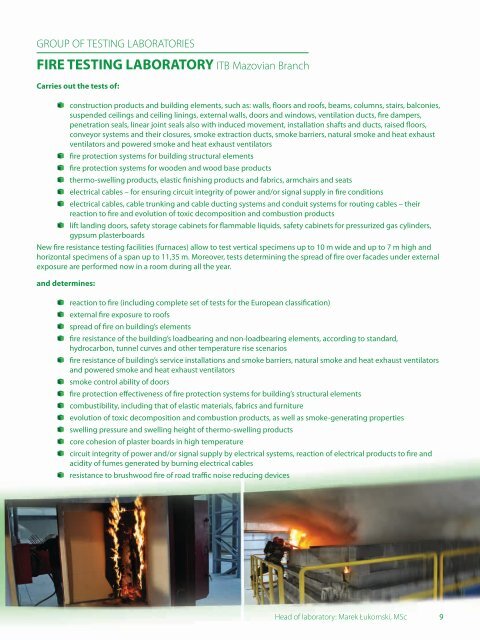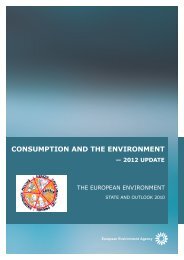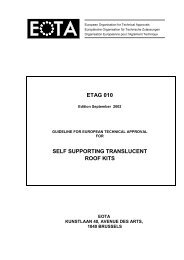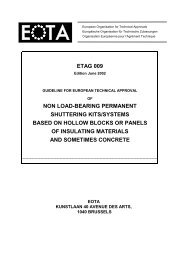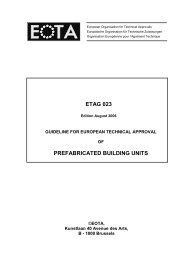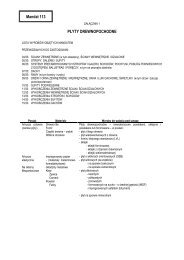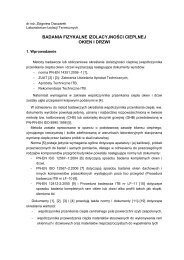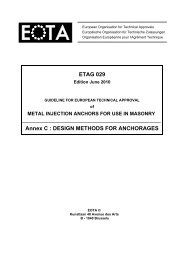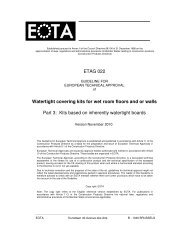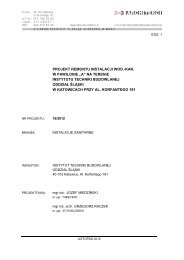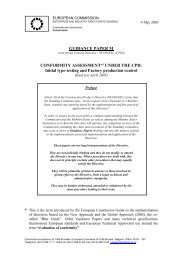ZespóŠLaboratoriów Badawczych ITB (.pdf) - 1,8 MB
ZespóŠLaboratoriów Badawczych ITB (.pdf) - 1,8 MB
ZespóŠLaboratoriów Badawczych ITB (.pdf) - 1,8 MB
You also want an ePaper? Increase the reach of your titles
YUMPU automatically turns print PDFs into web optimized ePapers that Google loves.
GROUP OF TESTING LABORATORIES<br />
FIRE TESTING LABORATORY <strong>ITB</strong> Mazovian Branch<br />
Carries out the tests of:<br />
construction products and building elements, such as: walls, floors and roofs, beams, columns, stairs, balconies,<br />
suspended ceilings and ceiling linings, external walls, doors and windows, ventilation ducts, fire dampers,<br />
penetration seals, linear joint seals also with induced movement, installation shafts and ducts, raised floors,<br />
conveyor systems and their closures, smoke extraction ducts, smoke barriers, natural smoke and heat exhaust<br />
ventilators and powered smoke and heat exhaust ventilators<br />
fire protection systems for building structural elements<br />
fire protection systems for wooden and wood base products<br />
thermo-swelling products, elastic finishing products and fabrics, armchairs and seats<br />
electrical cables – for ensuring circuit integrity of power and/or signal supply in fire conditions<br />
electrical cables, cable trunking and cable ducting systems and conduit systems for routing cables – their<br />
reaction to fire and evolution of toxic decomposition and combustion products<br />
lift landing doors, safety storage cabinets for flammable liquids, safety cabinets for pressurized gas cylinders,<br />
gypsum plasterboards<br />
New fire resistance testing facilities (furnaces) allow to test vertical specimens up to 10 m wide and up to 7 m high and<br />
horizontal specimens of a span up to 11,35 m. Moreover, tests determining the spread of fire over facades under external<br />
exposure are performed now in a room during all the year.<br />
and determines:<br />
reaction to fire (including complete set of tests for the European classification)<br />
external fire exposure to roofs<br />
spread of fire on building’s elements<br />
fire resistance of the building’s loadbearing and non-loadbearing elements, according to standard,<br />
hydrocarbon, tunnel curves and other temperature rise scenarios<br />
fire resistance of building’s service installations and smoke barriers, natural smoke and heat exhaust ventilators<br />
and powered smoke and heat exhaust ventilators<br />
smoke control ability of doors<br />
fire protection effectiveness of fire protection systems for building’s structural elements<br />
combustibility, including that of elastic materials, fabrics and furniture<br />
evolution of toxic decomposition and combustion products, as well as smoke-generating properties<br />
swelling pressure and swelling height of thermo-swelling products<br />
core cohesion of plaster boards in high temperature<br />
circuit integrity of power and/or signal supply by electrical systems, reaction of electrical products to fire and<br />
acidity of fumes generated by burning electrical cables<br />
resistance to brushwood fire of road traffic noise reducing devices<br />
Head of laboratory: Marek Łukomski, MSc<br />
9


